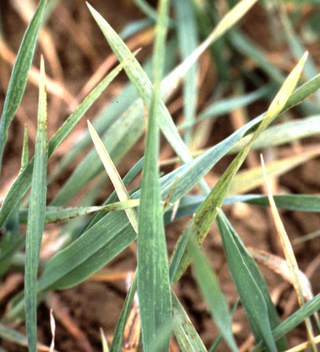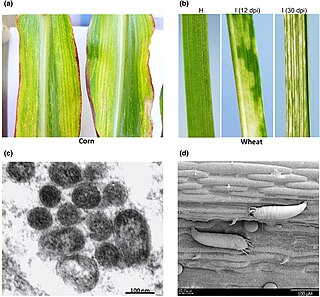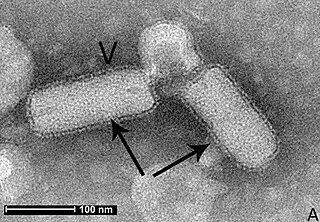
A cereal is a grass cultivated for its edible grain. Cereals are the world's largest crops, and are therefore staple foods. They include rice, wheat, rye, oats, barley, millet, and maize. Edible grains from other plant families, such as buckwheat and quinoa, are pseudocereals. Most cereals are annuals, producing one crop from each planting, though rice is sometimes grown as a perennial. Winter varieties are hardy enough to be planted in the autumn, becoming dormant in the winter, and harvested in spring or early summer; spring varieties are planted in spring and harvested in late summer. The term cereal is derived from the name of the Roman goddess of grain crops and fertility, Ceres.

Wheat is a grass widely cultivated for its seed, a cereal grain that is a staple food around the world. The many species of wheat together make up the genus Triticum ; the most widely grown is common wheat. The archaeological record suggests that wheat was first cultivated in the regions of the Fertile Crescent around 9600 BC. Botanically, the wheat kernel is a caryopsis, a type of fruit.

The oat, sometimes called the common oat, is a species of cereal grain grown for its seed, which is known by the same name. Oats appear to have been domesticated as a secondary crop, as their seeds resembled those of other cereals closely enough for them to be included by early cultivators. Oats tolerate cold winters less well than cereals such as wheat, barley, and rye, but need less summer heat and more rain, making them important in areas such as Northwest Europe that have cool wet summers. They can tolerate low-nutrient and acid soils. Oats grow thickly and vigorously, allowing them to outcompete many weeds, and compared to other cereals are relatively free from diseases.

Rye is a grass grown extensively as a grain, a cover crop and a forage crop. It is grown principally in an area from Eastern and Northern Europe into Russia. It is much more tolerant of cold weather and poor soil than other cereals, making it useful in those regions; its vigorous growth suppresses weeds and provides abundant forage for animals early in the year. It is a member of the wheat tribe (Triticeae) which includes the cereals wheat and barley. Rye grain is used for bread, beer, rye whiskey, and animal fodder. In Scandinavia, rye was a staple food in the Middle Ages, and rye crispbread remains a popular food in the region. Europe produces around half of the world's rye; relatively little is traded between countries. A wheat-rye hybrid, triticale, combines the qualities of the two parent crops and is produced in large quantities worldwide. In European folklore, the Roggenwolf is a carnivorous corn demon or Feldgeist.

Brome mosaic virus (BMV) is a small, positive-stranded, icosahedral RNA plant virus belonging to the genus Bromovirus, family Bromoviridae, in the Alphavirus-like superfamily.
Barley yellow dwarf (BYD) is a plant disease caused by the barley yellow dwarf virus (BYDV), and is the most widely distributed viral disease of cereals. It affects the economically important crop species barley, oats, wheat, maize, triticale and rice.
Furovirus is a genus of viruses, in the family Virgaviridae. Graminae, winter wheat, wheat, triticale, oat, sorghum bicolor, and plants serve as natural hosts. There are six species in this genus. Diseases associated with this genus include: (SBWMV): green and yellow mosaic.

The Russian wheat aphid is an aphid that can cause significant losses in cereal crops. The species was introduced to the United States in 1986 and is considered an invasive species there. This aphid is pale green and up to 2 mm long. Cornicles are very short, rounded, and appear to be lacking. There is an appendage above the cauda giving the aphid the appearance of having two tails. The saliva of this aphid is toxic to the plant and causes whitish striping on cereal leaves. Feeding by this aphid will also cause the flag leaf to turn white and curl around the head causing incomplete head emergence. Its host plants are cereal grain crops including wheat and barley and to a lesser extent, wild grasses such as wheatgrasses, brome-grasses, ryegrasses and anything in the grass family.
Polymyxa graminis is a species of plasmodiophorid cercozoans. It is an obligate parasite of plant roots and, though itself non-pathogenic, is responsible for the transmission of several very important plant viruses, including barley yellow mosaic virus (BaYMV) and soil-borne wheat mosaic virus (SBWMV).

Abacarus hystrix, the cereal rust mite or grain rust mite, belongs to the family Eriophyidae. They are extremely small with adults measuring up to 1 millimetre in length and only have four legs at the front of the body. Viewing by the human eye requires a 10 – 20X lens. The adult mites are usually yellow but also have been seen to be white or orange. The cereal rust mite was first found on Elymus repens, a very common perennial grass species. It has now been found on more than 60 grass species including oats, barley, wheat and ryegrass, found in Europe, North America, South Africa and Australia. Mites migrate primarily through wind movement and are usually found on the highest basal sections of the top two leaf blades. Abacarus hystrix produces up to twenty overlapping generations per year in South Australian perennial pastures, indicating that the species breeds quite rapidly. It has been noted that the cereal rust mite can cause losses in yield of up to 30-70%.

Barley yellow mosaic virus is plant pathogenic virus that causes the yellow mosaic disease of barley. Its shape is categorized as being flexuous filamentous, with lengths of 275 and 550 nanometers. The virus has a limited host range, and barley appears to be the only known susceptible host. The virus is transmitted via Polymyxa graminis, which is a plasmodiophorid protist, through the resting spores that survive in the soil, and eventually zoospores. Eastern Asia is the most affected region, but the virus can be found worldwide. Current agricultural practices have been ineffective at eliminating the virus, but breeding resistance appears to be the only way to help reduce the disease.
Panicum mosaic virus (PMV) is a positive-sense single-stranded RNA viral pathogen that infects plant species in the panicoid tribe of the grass family, Poaceae. The pathogen was first identified in Kansas in 1953 and most commonly causes disease on select cultivars of turf grass, switchgrass, and millet. The disease most commonly associated with the panicum mosaic virus pathogen is St. Augustine Decline Syndrome, which infects species of turf grass and causes chlorotic mottling. In addition to St. Augustine Decline, panicum mosaic virus is responsible for chlorotic streaking and mild green mosaicking in select cultivars of switchgrass and millet.
Winter wheat Russian mosaic virus (WWRMV) is a plant pathogenic virus. It is probably a strain of the species Cytorhabdovirus gramineae.

Wheat streak mosaic virus (WSMV) is a plant pathogenic virus of the family Potyviridae that infects plants in the family Poaceae, especially wheat ; it is globally distributed and vectored by the wheat curl mite, particularly in regions where wheat is widely grown. First described in Nebraska in 1922, stunted growth and the eponymous “streaks” of yellowed, non-uniform discoloration are characteristic of WSMV infection. As it has been known to cause 100% crop mortality, WSMV is a subject of ongoing scientific research.
Soil-borne wheat mosaic virus is a rod-shaped plant pathogen that can cause severe stunting and mosaic in susceptible wheat, barley and rye cultivars. The disease has often been misdiagnosed as a nutritional problem, but this has actually allowed in part for the fortuitous visual selection by breeding programs of resistant genotypes. Soil-borne wheat mosaic virus is part of the genus Furovirus. Members of this genus are characterized by rigid rod-shaped particles and positive sense RNA genomes consisting of two molecules that are packaged into separate particles that code for either replication, mobility, structure or defense against the host. The virus is spread by a fungal-like protist, Polymyxa graminis, whose asexual secondary and sexual primary cycles help the virus spread. The disease produces secondary symptoms from the root cell infection. The disease is a serious contributor to loss in crop yield.

Barley, a member of the grass family, is a major cereal grain grown in temperate climates globally. It was one of the first cultivated grains; it was domesticated in the Fertile Crescent around 9000 BC, giving it nonshattering spikelets and making it much easier to harvest. Its use then spread throughout Eurasia by 2000 BC. Barley prefers relatively low temperatures and well-drained soil to grow. It is relatively tolerant of drought and soil salinity but is less winter-hardy than wheat or rye.

High Plains wheat mosaic emaravirus (WMoV), or High Plains virus (HPV) or Maize red stripe virus (MRSV/MRStV) is the causative agent of High plains disease of maize and wheat. It is spread by wheat curl mite, Aceria tosichella, which also transmits Wheat streak mosaic virus. The mite's ability to transmit a number of different viruses to cereal crops make it an economically important agricultural pest. In late June 2017 this virus was first detected in Canada, in Alberta. The Alberta samples were 99% similar to those in the USA. As Wheat streak mosaic virus is already present in Alberta, and coinfection with these two causes even more severe damage, this could cause much higher yield losses.

Aceria tosichella, commonly known as the wheat curl mite (WCM), is a global cereal pest and a vector for spreading and transmission of viruses like wheat streak mosaic virus (WSMV) and wheat mosaic virus (WMoV)

Bird cherry-oat aphid is an aphid in the superfamily Aphidoidea in the order Hemiptera. It is a true bug and sucks sap from plants. It is considered a major pest in cereal crops, especially in temperate regions, as well as other hosts in parts of Northern Europe. It is the principal vector of many viruses in economically important field crops.

Cytorhabdovirus is a genus of viruses in the family Rhabdoviridae, order Mononegavirales. Plants serve as natural hosts.













